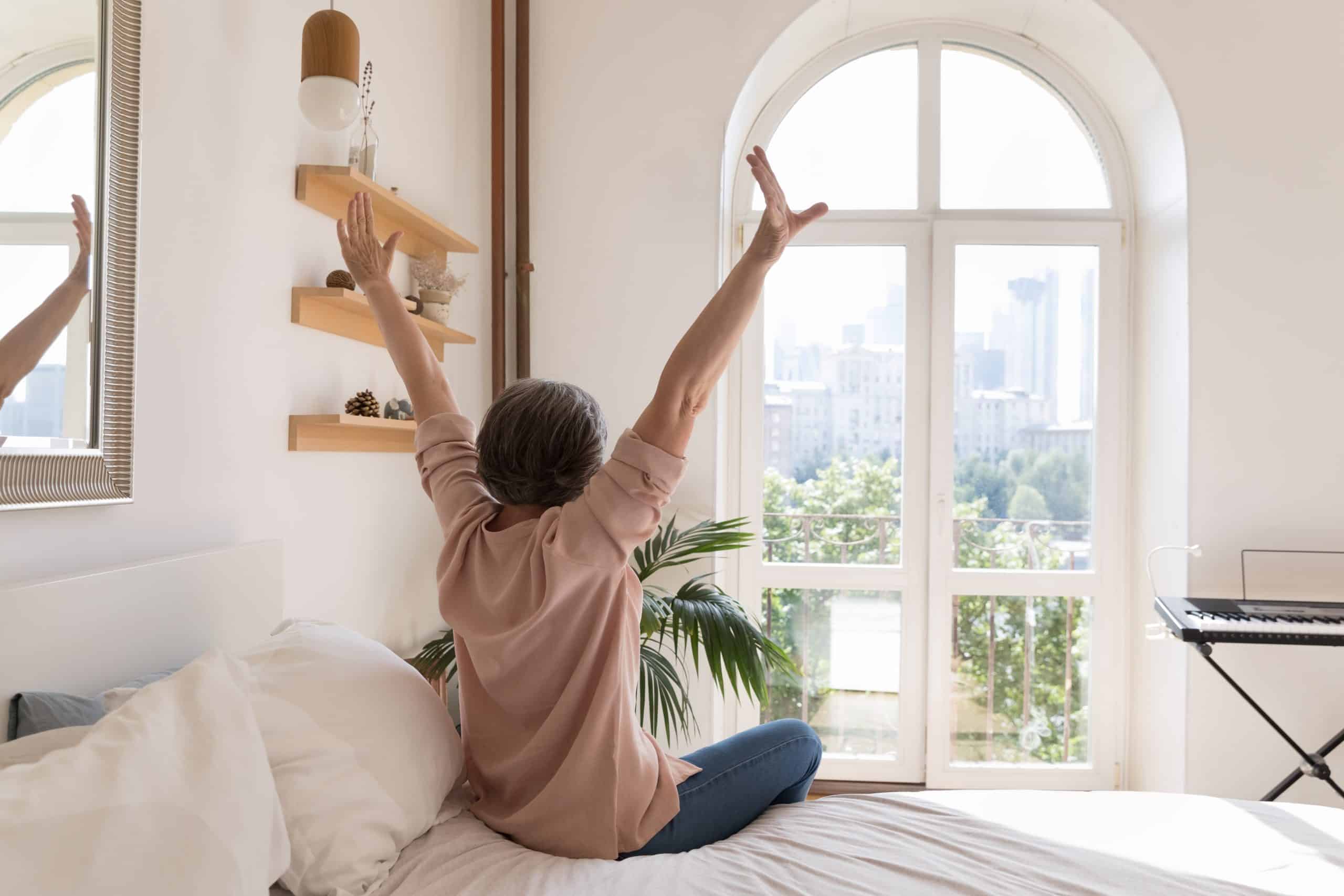According to both the Sleep Foundation and the Centers for Disease Control and Prevention, the average adult needs at least seven hours a night for good health and well being. Getting good quality sleep is known to help reduce your risk of chronic illnesses, boost weight loss, improve cognitive functioning, reduce stress and improve mood among many other benefits. That said, have you ever thought to use sleep to improve posture? We all probably grew up with our parents and teachers reminding us to sit up or stand straight and fix our postures. While we did so as they were looking at us, no sooner than their backs were turned we then hunched back over. Many of us never thought too much about this and now we’re all grown up adults with bad posture and the numerous problems caused by this. Fortunately for us, there is a way to use something as simple as sleep to fix posture. So how should you sleep to improve your posture? Read on to find out!
Why Good Posture Matters
Can you improve posture while sleeping? As improbable as that sounds, yes you can use sleep correct posture. However, before we get into how this works, here are reasons why you should be aiming to fix how you sit/stand.
Some benefits of improved posture include
- Improved circulation – Poor circulation is an issue that occurs when something interferes with the circulatory system preventing it from delivering oxygen and nutrient rich blood to all parts of the body, especially the extremities. Over the years multiple studies have shown that bad posture can cause harm in the flow of blood within the body (4, 8).
- Increases lung capacity – Lung capacity refers to how much oxygen one can hold while breathing in. According to the National Library of Medicine, healthy adults can hold about 6 liters of air – although this can be affected by matters like age, gender, body composition, and ethnicity (10).
Studies have shown that when compared to normal upright posture, bad posture significantly reduces lung capacity, expiratory flow, and lumbar lordosis. One study published in The Journal of Physical Therapy Science in 2016 looked at respiratory function of people sitting upright and those looking down at their smartphones. Researchers found that sitting hunched in the ‘smartphone position’ significantly reduced respiratory function (5).
- Better mood and energy – This is linked to the two points above. Improved circulation and increased lung capacity means that your body gets the nutrients and oxygen it needs to function its best.
- Improved cognitive function – One study published in 2021 showed that people who often sat in slouched positions had more negative moods and were slower to process information as compared to those who sat upright (7).
- Improves balance – Good balance is essential for walking and working out. It is also especially important for older adults who are very prone to falling over and injuring themselves.
- Prevents chronic neck, hip, and back pain – Several studies have shown that bad posture causes pain in these areas.
- Neck pain – A review published in late 2019 showed that while age is a significant factor in neck pain, forward head posture (i.e. think looking down at a phone or laptop keyboard) significantly increases neck pain and its intensity in adults and older adults (12).
- Back pain – A study done on adolescents and published in 2021 showed that prolonged sitting with slumped posture can increase the risk of experiencing low back discomfort and pain (6). An older study published in the Journal of Physical Therapy Science in 2015 revealed that doing posture correction exercises helped to significantly reduce shoulder, middle back, and lower back pain (3).
- Hip pain – Poor posture and prolonged sitting are two major culprits of hip pain. A study published in the Musculoskeletal science and practice journal showed that prolonged sitting/physical inactivity lead to both hip muscle stiffness and pain (11). With this in mind, prolonged sitting, especially combined with bad posture will significantly increase the risk of hip pain.
- Improves confidence – A study done by researchers at the Ohio State University found that students who maintained good posture when assessing themselves for future employment rated themselves more positively than those who sat in slouched postures during the assessment (2).
Another study done by researchers at the San Francisco State University, found that students who solved a simple math equation in a slumped slouched position were less confident and more anxious about their ability and answers as compared to those who solved the equation while sitting up straight with shoulders back and relaxed (9).
Read More: Upper Spine Stretches: How To Relieve Upper Back Pain And Stiffness
What Is The Best Way To Sleep To Improve Posture?
Clearly, posture plays a very important role in a lot more things than we give it credit for. So what is the best sleeping position to improve posture?
According to the Sleep Foundation, all human beings sleep in three main positions and they all have their benefits and disadvantages (1). These positions include
- On the side – This is the most common position used by about 60 percent of people worldwide. It should be noted that this position is more common in adults than in children -because spine flexibility decreases with age – and men tend to spend more time on their side than women.
This position is great as it promotes healthy spinal alignment which greatly reduces the risk of back pain. It is also good for persons who suffer from heartburn, sleep apnea, pregnant women, and older adults.
- On the back – This is the second most popular position after side sleeping. Sleeping on your back is considered a good position as it is very easy to keep your back in alignment and it keeps your body weight evenly distributed. Proper back alignment and weight distribution greatly reduces any risk of either neck or back pain.
A point to note is that if you suffer from allergies or have a cold/flu, try sleeping in this position with pillows propping you upright as it helps relieve nasal congestion. While this position is fantastic for those who suffer from stuffy noses, neck or lumbar pain, it is not the position for heavier adults or anyone listed under the ‘on the side’ section.
- On your stomach – This is the least popular position and the one that most experts advise against. Experts say that when sleeping in this position, your ribcage is often fighting against gravity, which forces you to use more energy to breath. All the extra energy used to simply breath makes your sleep less restful.
Aside from this, stomach sleeping is also absolutely terrible for back support and alignment. Your spine has essentially no support in this position which often leads to back pain the next day. Suffering from back pain will have you sitting and standing with bad posture all day.
This position is also bad for your neck. In order to breathe, you have to turn your neck to either side which again, takes the spine out of alignment. If your mattress isn’t firm enough, your stomach and hips sink into the bed further misaligning the spine. All this misalignment doesn’t just mean back pain, but it will also cause neck as well as hip pain.
Sleeping on your stomach isn’t all bad. In some cases, it can help open up your airway reducing snoring, but even with that the disadvantages outweigh the benefits. That said, you are better off avoiding this position at all costs.
Whether you’re a workout beast or just a beginner making your first foray into the world of fitness and dieting – BetterMe has a lot to offer to both newbies and experts! Install the app and experience the versatility first-hand!
How To Sleep For Better Posture – Simple Tips For Spine Alignment
So what is the best position to sleep in for posture? Interesting enough, there is no one position that works perfectly. The best thing to do to try and fix your posture while sleeping is to make sure that your spine is aligned in whichever position feels most comfortable for you.
Two factors greatly affect your spine alignment while asleep:
- Your mattress – Like with sleep positions, there is no one-size fits all formula to picking the right mattress.
The best advice we could offer you when it comes to choosing one is to make sure you get one that supports your body in a way that feels natural and comfortable. Anything too hard or soft will take the spine out of alignment.
- Your pillow – As mentioned above, when your neck and spine are not well aligned it leads to both neck and back pain which leads to bad posture once you wake up.
When choosing a pillow, find one that is neither too hard nor too soft and one that supports the natural curve of your neck in your favorite sleeping position. According to WebMD,
- Side sleepers need the thickest pillows as compared to all others. Your pillow of choice should comfortably fill in the space between your ear and the bed. Placing a second pillow between your knees is also highly advisable as it further aligns the spine and keeps any extra pressure from the hips and lower back.
- Back sleepers do not need a pillow as thick as side pillows. As a back sleeper, you should choose a pillow that comfortably fills in the space between your ear and the bed and also supports your head, neck, and the natural curve of your shoulders. If you lie down and can see your feet, this pillow is too high – you will very likely wake up with neck pain.
- Stomach sleepers should sleep without a pillow if possible as this is the best way to keep their spine as neutral as possible. If as a stomach sleeper you feel like you need a pillow, choose one that’s small and flat.
Read More: Spinach Vs. Broccoli: The Ultimate Veggie Showdown
How To Improve Your Spine Posture
As mentioned above, perfect sleeping posture is determined both by your mattress and pillow. Avoid mattresses that are too firm that you feel like you are sleeping on a rock or a block or wood and pillows that are too high or low, depending on your preferred sleeping position.
The Bottom Line
At the end of the day, the question of ‘how should you sleep to improve your posture’ is answered by three things – your favorite sleep position, mattress and pillow. These three factors work together to ensure that your neck, spine, back and hips are in the proper position. Remember that good posture isn’t just for waking hours alone.
DISCLAIMER:
This article is intended for general informational purposes only and does not address individual circumstances. It is not a substitute for professional advice or help and should not be relied on to make decisions of any kind. Any action you take upon the information presented in this article is strictly at your own risk and responsibility!
SOURCES:
- Best Sleeping Positions (2023, sleepfoundation.org)
- Body Posture Affects Confidence In Your Own Thoughts, Study Finds (2009, sciencedaily.com)
- Effect of an exercise program for posture correction on musculoskeletal pain (2015, jstage.jst.go.jp)
- Effect of Changes in Posture on Peripheral Circulation, with Special Reference to Skin Temperature Readings and the Plethysmogram (1950, ahajournals.org)
- Effect of sitting posture on respiratory function while using a smartphone (2016, ncbi.nlm.nih.gov)
- Effects of Prolonged Sitting with Slumped Posture on Trunk Muscular Fatigue in Adolescents with and without Chronic Lower Back Pain (2021, ncbi.nlm.nih.gov)
- Embodiment: I sat, I felt, I performed – Posture effects on mood and cognitive performance (2021, sciencedirect.com)
- How posture influences venous blood flow in the lower limbs: results of a study using photoplethysmography (2017, pubmed.ncbi.nlm.nih.gov)
- Math + good posture = better scores (2018, news.sfsu.edu)
- Physiology, Lung Capacity (2022, ncbi.nlm.nih.gov)
- Prolonged sitting and physical inactivity are associated with limited hip extension: A cross-sectional study (2021, sciencedirect.com)
- The Relationship Between Forward Head Posture and Neck Pain: a Systematic Review and Meta-Analysis (2019, link.springer.com)












